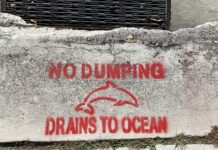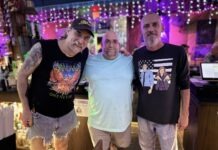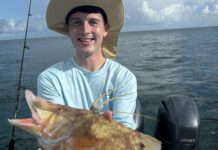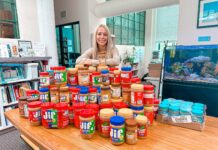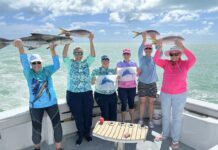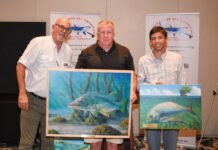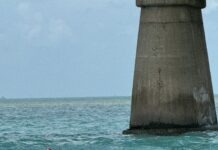
Here in the Florida Keys, we have four types of mackerel. In this article, I’m going to name and describe each of the four and give you the best techniques, places and times to catch them.
Spanish mackerel are the smallest, and probably the most plentiful. Spanish mackerel can be easily identified by their bright yellow polka dots. We like to target Spanish mackerel in the spring and fall. They come in close when the weather is mild, and they don’t like it too hot or too cold. We typically target Spanish mackerel at the reef lines in the Atlantic, and 8 or 10 miles out in the Gulf of Mexico. The best technique to catch Spanish mackerel is with a block of chum and a chum ring using live pilchards pectoral hooked with a long-shank J hook or artificial bait, such as silver spoons and red and white feather jigs. Many times we’ll tip the jigs with live shrimp – hook them up from the chin through the top of the head, missing the brain, make the hook flush with the shrimp’s horn, and jig it through the mid column of the water. Many people feel that Spanish mackerel is a fishy-tasting oily fish, best smoked, grilled or baked. Spanish mackerel season is open year-round; you can keep up to 15 per angler per day, and they must measure 12 inches from the tip of the top lip to the fork of the tail down the lateral line of the fish.
Cero mackerel are the second-smallest of the Florida Keys mackerel, and probably the second most plentiful. They are easily identifiable by their yellow dashes and thick yellow lateral line. cero mackerel season is open year-round. There is no size limit for cero mackerel, but there is a 100-pound bag limit per person per day. We like to target cero mackerel during the same times and places as the Spanish mackerel. Both Spanish mackerel and cero mackerel are best targeted in the middle of the day, as we typically don’t catch them early in the morning or late in the afternoon. We use the same techniques to catch cero mackerel as we do Spanish mackerel. However, since cero mackerel are usually a bit larger than Spanish mackerel, we do best targeting them with large pilchards hooked in the nose plate with a long-shank J hook. Since mackerel are such toothy critters, if the water is murky, we like to use a 6- or 8-inch piece of 25-pound test wire leader to the hook. If the water is clear, the mackerel are smart enough to see the wire leader and we have to use a 20- or 40-pound mono fluorocarbon leader. When using mono rather than wire, we lose more fish, but we get more hits. Cero mackerel taste very similar to wahoo, which many people say is their favorite table fare. Less fishy tasting and less oily than a Spanish mackerel, cero mackerel can only be caught in the Florida Keys waters and south. For example, I’ve never caught one north of Fort Myers on the west coast of Florida or north of Palm Beach on the east coast of Florida.
King mackerel, also called kingfish, are the second-largest of the Florida Keys mackerel and very plentiful during spring and fall. A king mackerel is a solid silver fish prevalent all up and down the eastern seaboard in the Atlantic Ocean and in every region of the Gulf of Mexico. It is one of, if not the most-celebrated saltwater game fish, as there are numerous kingfish tournaments nationwide. The main attraction of king mackerel is their speed and power. A common nickname for the kingfish is “smoker king.” Some people think the nickname comes from the best way to cook a kingfish, which is to smoke it, but the true reason it got the nickname “smoker king” is thar it initially hits with so much velocity that it can smoke your reel and make a long hard run. It’s not uncommon for a king fish to launch 10 or 20 feet in the air on its initial strike. That’s typically the only jump that you will get out of a kingfish during the battle. The rest of the fight is hard zigzagging runs. We target kingfish in many different ways. We like to troll for them, bump troll, drift or even anchor and chum with live bait and artificial baits. Kingfish is also considered a fishy-tasting oily fish, much like the Spanish mackerel. King mackerel season is also open year-round, and fish must measure 24 inches from the tip of their nose to the fork of their tail down the lateral line of the fish. The bag limit is 3 per person per day. King mackerel is also heavily harvested by commercial fisherman throughout the eastern seaboard and Gulf of Mexico.
Wahoo is the largest of the mackerel family, and the rarest. Wahoo is considered by most anglers as a trophy fish because they’re so hard to target and catch, along with their unique beauty and unreal fight. Wahoo have beautiful tiger-striped colors with hues of blue, black and purple. Wahoo are some of the fastest fish in the ocean, clocked at up to 60 miles per hour. Many times we’ll high-speed troll at 14 mph with an in-line weight rigged with a cable and troll a black and purple plastic Tormenter lure on 250-pound test mono leader. When you’re trolling that fast, you’ll feel like nothing could hit a bait going that speed, but feeding at 14 mph is nothing for a wahoo. We also troll at 6 or 8 mph with pink and purple Nomad lures. We also target wahoo on wrecks and ledges using live baby bonita, free lined or under a balloon. If we find a floater offshore, we also like to vertical jig for wahoo. The fall and winter months are the best time of year to target wahoo, especially during the full moon on a no-wind blue bird day. Like the other mackerel, wahoo season is open year-round. Wahoo has no size limit, but has a bag limit of 2 per day per angler. Wahoo is my favorite fish to fight and to eat.
As we enter into fall, we anticipate an awesome mackerel season. Come down to the Florida Keys and experience one of the most exciting species of fish in the world.
To book a charter with Ana Banana, call or text Capt. Joel at 813-267-4401 or Capt. Jojo at 305-879-0564, or visit anabananafishing.com.


